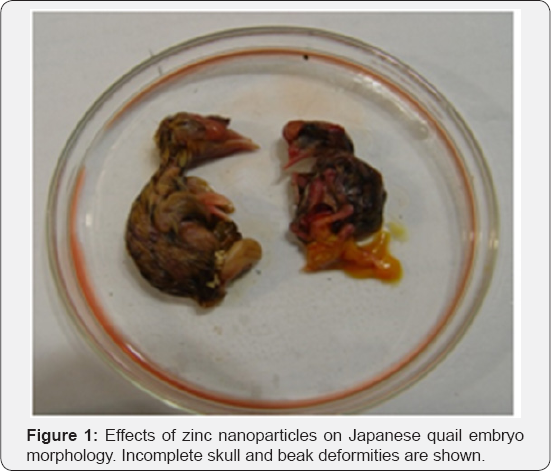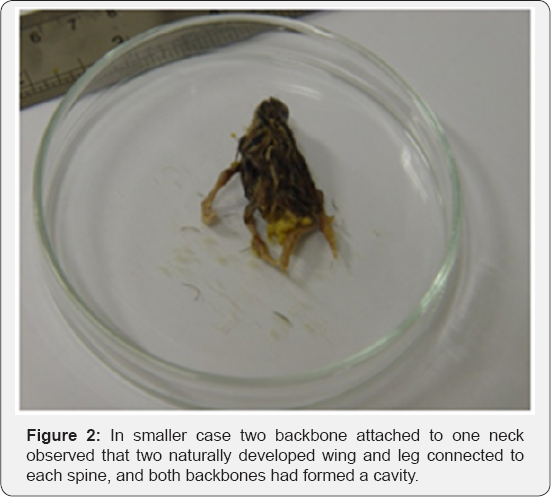Abnormalities in Unhatched Chicks of Japanese Quails Fed with Zinc Oxide Nanoparticles-Juniper Publishers
JUNIPER PUBLISHERS-OPEN ACCESS JOURNAL OF DAIRY & VETERINARY SCIENCES
Abstract
According to some reports, zinc oxide nanoparticles (ZnONs) are toxic. Therefore, their toxicity was assessed in Japanese quail offspring, which breeders were fed with ZnONs. Two abnormal chicks were observed in this report. It is concluded that ZnONs have the teratogenic potential in Japanese quail embryos and these results confirm that ZnONs could pose the potential risk for animal and human health.
Keywords: Japanese quail; Zinc oxide nanoparticles; Embryonic abnormalities
Introduction
In the past few years, with the rapid development of nanotechnology and owing to their wide industrial and commercial applications, manufactured nanomaterials are now used in pharmaceutics, commodities, biomedical products, human and animal foods [1,2]. Nanoscale materials possess more novel, unique and specific physicochemical properties such as durability and chemical reactivity compared to bulk materials [3]. Thus, because of their small size, nanoparticles (NPs) can penetrate into the cell membrane and interfere in important cell functions. Studies have demonstrated that the size of NPs also affects their efficiency [4,5]. Recently, Zinc nanoparticles have been considered as an important factor animal science [6] that one of its applications is as dietary zinc source. Some of researchers reported that bioavailability of Zn nanoparticles is high and demonstrated that use of ZnONs in broiler diets led to improve growth performance [7]. Also there has shown that dietary supplementation with ZnONs in rat causes of fertility increasement [8]. However, in some of the studies adverse effects of nanoparticles on the reproduction and embryos of laboratory animals were reported [9]. There are few reports in related to supplementation of diet with ZnONs on the Japanese quail embryo. Therefore the aim of this report is to describe Japanese quail embryo abnormality due to use of ZnONs in diet.
Case Presentation
In our investigation, two malformed chicks were observed in offspring of breeder Japanese quails fed with zinc oxide nanoparticles (Figure 1). The embryos have been died between the 14th to 17th days of incubation. In the first case, the chicken brain was protruded (nude brain) and was without the eyes and upper beak was incomplete, but there was no abnormality in the internal organs after an autopsy. In second case (Figure 2), the chicken was smaller than first case and its appearance characteristics were: no upper break, protruded brain, two backbone attached to one neck, that two naturally developed wing and leg connected to each spine, and both backbone had formed a cavity. After the autopsy, we observed an abnormal heart, and enlarged liver in meddle of abdominal cavity. The gizzard size was relatively large with cylindrical shape that located in the centre of cavity and two series of intestine with normal appearance was attached to gizzard that each of them individually was terminated to a vent.


Discussion
Several parameters influence what happens at the nanobio interface and thus determine the toxic potential of any given NP [3]. Besides the chemical composition of the NP, size, surface modification, shape and polarity have to be considered to be biologically active. The reasons suggested for cellular damage caused by NP exposure include production of toxic radicals [10] and interaction with DNA [11]. Therefore, the results of nanoparticle toxicity studies can be of considerable heterogeneity. In somatic cells such insults cause inflammation or even malignant transformation. Multitude studies reported, most have shown the ability of NPs to effectively cross biological barriers including the ones protecting the reproductive and brain tissue. In germ line cells, either defect might lead to impaired fertility and congenital defects in the offspring [12]. It was noted that NPs distributed to the placenta and fetuses of exposed pregnant dams and to the milk and pups of exposed lactating dams [13].
In our investigation, two malformed chicks were observed in offspring of breeder Japanese quails fed with zinc oxide nanoparticles. It shows that nanoparticle supplementation in breeder Japanese quail diet may have detrimental effects on offspring development. This was supported with the previous studies that have indicated prenatal NPs exposure NPs found in many products causes alteration to the cerebral cortex, poor fetal growth, development retardation, low birth weight in unborn and newborn infants and other dysfunctions in offspring [1416]. Also researchers detected a cytotoxic effect of NPs on rodent testes and spermatogenesis caused the consequent fluctuation of sperm and testosterone levels [17]. It is concluded that ZnONs have the teratogenic potential in Japanese quail embryos and these results confirm that ZnONs could pose potential risk for animal and human health.
For more Open Access Journals in Juniper Publishers please click on: https://juniperpublishers.com/open-access.php
For more articles in Open Access Journal of Dairy & Veterinary sciences please click on: https://juniperpublishers.com/jdvs/index.php



Comments
Post a Comment